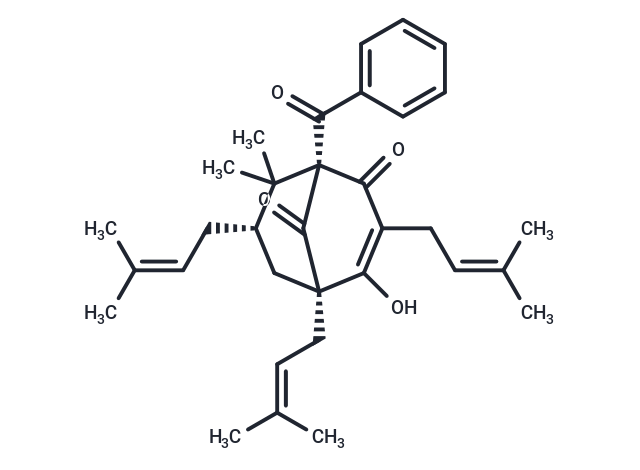- Remove All
 Your shopping cart is currently empty
Your shopping cart is currently empty
Nemorosone
Nemorosone is a polycyclic polyprenylated acylphloroglucinol (PPAP) originally isolated from C. rosea that has antiproliferative properties.1 Nemorosone inhibits growth of NB69, Kelly, SK-N-AS, and LAN-1 neuroblastoma cells (IC50s = 3.1-6.3 μM), including several drug-resistant clones, but not MRC-5 human embryonic fibroblasts (IC50 = >40 μM).2 It increases DNA fragmentation in LAN-1 cells in a dose-dependent manner, and decreases N-Myc protein levels and phosphorylation of ERK1/2 by MEK1/2. Nemorosone also inhibits growth of Capan-1, AsPC-1, and MIA-PaCa-2 pancreatic cancer cells (IC50s = 4.5-5.0 μM following a 72-hour treatment) but not human dermal and foreskin fibroblasts (IC50s = >35 μM).1 It induces apoptosis, abolishes the mitochondrial membrane potential, and increases cytosolic calcium concentration in pancreatic cancer cells in a dose-dependent manner. Nemorosone activates the caspase cascade in a dose-dependent manner and inhibits cell cycle progression, increasing the proportion of cells in the G0/G1 phase, in both neuroblastoma and pancreatic cancer cells.1,2 Nemorosone (50 mg/kg, i.p., per day) also reduces tumor growth in an MIA-PaCa-2 mouse xenograft model.3

Nemorosone
| Pack Size | Price | Availability | Quantity |
|---|---|---|---|
| 1 mg | Inquiry | 35 days | |
| 5 mg | Inquiry | 35 days | |
| 10 mg | Inquiry | 35 days |
Product Introduction
| Description | Nemorosone is a polycyclic polyprenylated acylphloroglucinol (PPAP) originally isolated from C. rosea that has antiproliferative properties.1 Nemorosone inhibits growth of NB69, Kelly, SK-N-AS, and LAN-1 neuroblastoma cells (IC50s = 3.1-6.3 μM), including several drug-resistant clones, but not MRC-5 human embryonic fibroblasts (IC50 = >40 μM).2 It increases DNA fragmentation in LAN-1 cells in a dose-dependent manner, and decreases N-Myc protein levels and phosphorylation of ERK1/2 by MEK1/2. Nemorosone also inhibits growth of Capan-1, AsPC-1, and MIA-PaCa-2 pancreatic cancer cells (IC50s = 4.5-5.0 μM following a 72-hour treatment) but not human dermal and foreskin fibroblasts (IC50s = >35 μM).1 It induces apoptosis, abolishes the mitochondrial membrane potential, and increases cytosolic calcium concentration in pancreatic cancer cells in a dose-dependent manner. Nemorosone activates the caspase cascade in a dose-dependent manner and inhibits cell cycle progression, increasing the proportion of cells in the G0/G1 phase, in both neuroblastoma and pancreatic cancer cells.1,2 Nemorosone (50 mg/kg, i.p., per day) also reduces tumor growth in an MIA-PaCa-2 mouse xenograft model.3References1. Holtrup, F., Bauer, A., Fellenberg, K., et al. Microarray analysis of nemorosone-induced cytotoxic effects on pancreatic cancer cells reveals activation of the unfolded protein response (UPR). Br. J. Pharmacol. 162(5), 1045-1059 (2011).2. Díaz-Carballo, D., Malak, S., Bardenheuer, W., et al. Cytotoxic activity of nemorosone in neuroblastoma cells. J. Cell. Mol. Med. 12(6B), 2598-2608 (2008).3. Wold, R.J., Hilger, R.A., Hoheisel, J.D., et al. In vivo activity and pharmacokinetics of nemorosone on pancreatic cancer xenografts. PLoS One 8(9), e74555 (2013). Nemorosone is a polycyclic polyprenylated acylphloroglucinol (PPAP) originally isolated from C. rosea that has antiproliferative properties.1 Nemorosone inhibits growth of NB69, Kelly, SK-N-AS, and LAN-1 neuroblastoma cells (IC50s = 3.1-6.3 μM), including several drug-resistant clones, but not MRC-5 human embryonic fibroblasts (IC50 = >40 μM).2 It increases DNA fragmentation in LAN-1 cells in a dose-dependent manner, and decreases N-Myc protein levels and phosphorylation of ERK1/2 by MEK1/2. Nemorosone also inhibits growth of Capan-1, AsPC-1, and MIA-PaCa-2 pancreatic cancer cells (IC50s = 4.5-5.0 μM following a 72-hour treatment) but not human dermal and foreskin fibroblasts (IC50s = >35 μM).1 It induces apoptosis, abolishes the mitochondrial membrane potential, and increases cytosolic calcium concentration in pancreatic cancer cells in a dose-dependent manner. Nemorosone activates the caspase cascade in a dose-dependent manner and inhibits cell cycle progression, increasing the proportion of cells in the G0/G1 phase, in both neuroblastoma and pancreatic cancer cells.1,2 Nemorosone (50 mg/kg, i.p., per day) also reduces tumor growth in an MIA-PaCa-2 mouse xenograft model.3 References1. Holtrup, F., Bauer, A., Fellenberg, K., et al. Microarray analysis of nemorosone-induced cytotoxic effects on pancreatic cancer cells reveals activation of the unfolded protein response (UPR). Br. J. Pharmacol. 162(5), 1045-1059 (2011).2. Díaz-Carballo, D., Malak, S., Bardenheuer, W., et al. Cytotoxic activity of nemorosone in neuroblastoma cells. J. Cell. Mol. Med. 12(6B), 2598-2608 (2008).3. Wold, R.J., Hilger, R.A., Hoheisel, J.D., et al. In vivo activity and pharmacokinetics of nemorosone on pancreatic cancer xenografts. PLoS One 8(9), e74555 (2013). |
| Molecular Weight | 502.695 |
| Formula | C33H42O4 |
| Cas No. | 351416-47-2 |
| Storage | Powder: -20°C for 3 years | In solvent: -80°C for 1 year | Shipping with blue ice. |
| Solubility Information | Ethanol: 30 mg/mL (59.68 mM), Sonication is recommended. DMSO: 30 mg/mL (59.68 mM), Sonication is recommended. Ethanol:PBS (pH7.2) (1:7): 0.13 mg/mL (0.26 mM), Sonication is recommended. DMF: 30 mg/mL (59.68 mM), Sonication is recommended. |
Calculator
In Vivo Formulation Calculator (Clear solution)
Dose Conversion
Tech Support
Keywords

Copyright © 2015-2025 TargetMol Chemicals Inc. All Rights Reserved.




